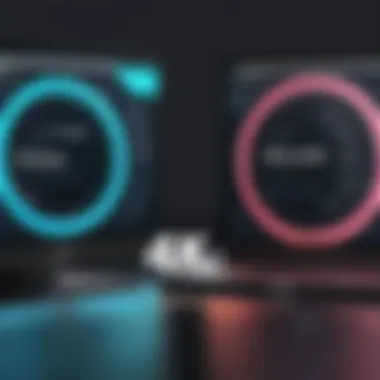Planoly vs Hootsuite: Key Features and Insights


Intro
In the realm of digital marketing, having the right tools can make or break your online strategy. When it comes to social media management, Planoly and Hootsuite often emerge as top contenders. Each platform caters to unique user needs and preferences, making it imperative for decision-makers and IT professionals to thoroughly evaluate their options before committing. This analysis takes a closer look at these two software giants. By delving into their features, pricing models, and user experiences, we not only highlight the strengths and weaknesses of each but also offer insights tailored for entrepreneurs aiming to enhance their brand’s online presence.
Key Software Features
Essential functionalities
Planoly is largely recognized for its visual planning and scheduling capabilities. The interface is intuitive and particularly shines for users managing Instagram marketing efforts. Features like a drag-and-drop content calendar and a grid preview allow for a seamless arrangement of posts, resulting in a visually appealing feed. Similarly, the platform offers features like auto-posting, analytics, and hashtag management, making it a robust tool for visual storytellers.
On the flip side, Hootsuite provides a broader scope of functionalities, catering to various social media platforms beyond just Instagram. With Hootsuite, users can manage Twitter, Facebook, LinkedIn, and more all in one centralized dashboard. Key functionalities include scheduling, monitoring engagement, and built-in analytics tools. Users can create custom reports—essential for those who base business decisions on data.
"Choosing the right tool isn’t about the price; it’s about aligning features with your social media strategy."
Advanced capabilities
When looking at advanced features, the distinctions become clearer. Planoly offers a limited scope centered mainly around visual content, which is likely appealing to brands heavily invested in imagery. However, its analytics features are less comprehensive compared to Hootsuite. In contrast, Hootsuite excels with features like team collaboration and multi-channel management. This is valuable for larger businesses or those dealing with multiple brand accounts.
Moreover, Hootsuite allows integration with over 150 apps and social networks. This capability can be crucial for businesses looking to harness diverse channels for engagement. If social media isn’t all about visuals for your brand, Hootsuite might be more aligned to your needs.
Comparison Metrics
Cost analysis
Budget considerations often dictate the choice between these two platforms. Planoly operates on a subscription basis, with tiers that cater to different user needs. The entry-level pricing is typically seen as advantageous for small brands or solo entrepreneurs. However, as businesses grow, users may face limitations on analytics and advanced features unless they upgrade to higher tiers.
Hootsuite’s pricing model is similarly tiered but generally accommodates a more comprehensive set of features—albeit at a higher starting cost. For larger organizations with multiple accounts, this can be more economical in the long run, as the advanced capabilities and integrations save time and provide deeper insights.
Performance benchmarks
In practice, user experiences heavily influence brand loyalty. Many users commend Planoly for its simplicity and ease of use. The platform delivers a straightforward approach, allowing users to focus on their content rather than grasping complex functionalities. On the other hand, Hootsuite's extensive features can provide a steep learning curve for newcomers, but the payoff can be significant in terms of engagement enhancement and data-driven decision-making.
Ultimately, the choice boils down to the specific needs of your business. Whether the focus is on stellar visuals or a comprehensive management experience, understanding the distinctive features and pricing models of Planoly and Hootsuite will guide you to a more informed decision.
Prolusion to Social Media Management Tools
In today’s hyper-connected world, a strong social media presence plays an indispensable role in any marketing strategy. With platforms like Instagram, Facebook, and Twitter becoming the lingua franca of online engagement, it's crucial to have the right tools to manage these vast networks. Social media management tools streamline the complex tasks associated with an effective social strategy— from scheduling posts to analyzing performance metrics. This article delves into two noteworthy tools, Planoly and Hootsuite, dissecting their offerings to help readers make informed choices.
Importance of Social Media Management
The significance of social media management can’t be overstated in the current digital landscape. Businesses, regardless of size, are increasingly realizing that they can't just throw content into the void and hope for the best. A thoughtful approach is necessary to foster community and engagement. Social media management tools offer numerous benefits including:
- Efficiency: Automating posts saves time, allowing marketers to focus on strategy rather than just execution.
- Strategic Insights: Built-in analytics provide a clearer picture of what’s working and what’s falling flat, enabling data-driven decisions.
- Brand Consistency: Keeping a uniform voice and aesthetic across platforms is easier when content is organized and scheduled in advance.
- Engagement Tracking: Monitoring audience reply and engagement metrics helps tailor future content to community preferences.
This emphasis on organized management translates into tangible results like improved brand loyalty and stronger customer relationships.
Overview of Popular Tools
When it comes to social media management, a handful of tools frequently come into the conversation, each vying for a spot in marketing professionals’ toolkits. Planoly and Hootsuite are two heavyweights, yet they cater to different needs and audiences.
- Planoly: Often regarded as the go-to tool for visually-focused platforms like Instagram and Pinterest, Planoly offers a sleek visual content calendar, making the planning and scheduling of posts nearly effortless. Its focus on aesthetics shines through its design tools, catering especially to brands that rely heavily on imagery.
- Hootsuite: On the other hand, Hootsuite provides a more expansive approach, encompassing multiple social platforms under one roof. It’s a comprehensive management solution, which means users can monitor engagement across Twitter, Facebook, LinkedIn, and more, all in one dashboard. Its robust analytics and reporting features make it a favorite among businesses that prioritize detailed performance metrics.
As we delve deeper into the unique attributes of Planoly and Hootsuite in this article, the differences will paint a clearer picture of which tool might better meet your specific social media needs.
Understanding Planoly


Grasping the ins and outs of Planoly is vital as it allows users to navigate social media management with confidence. This platform not only simplifies scheduling content but also enhances visual storytelling, making it indispensable for anyone serious about their online presence.
Key Features of Planoly
Visual Content Calendar
The Visual Content Calendar is a standout feature of Planoly that positions it as a preferred tool for many users. This particular aspect allows individuals and teams to see their scheduled posts at a glance, aiding significantly in planning and strategizing. The ability to visualize content provides clarity and aligns with the overall goal of maintaining a cohesive brand presence across platforms.
A key characteristic of the Visual Content Calendar is its drag-and-drop functionality, which makes rearranging posts an intuitive process. This feature is beneficial for those who are not tech-savvy, as it streamlines the organization of content. One unique aspect is the ability to add notes and links directly in the calendar, fostering collaborative efforts within teams. While it’s largely advantageous, users might find that the visual aspect can sometimes overwhelm, especially with extensive content scheduled.
Instagram and Pinterest Integration
Planoly shines in its integration capabilities, particularly with Instagram and Pinterest. This integration is paramount because these platforms are highly visual, and the effectiveness of content there often hinges on aesthetic appeal. By bridging with these networks, Planoly makes it easier to cross-promote and repurpose content without redundancy.
A key feature here is the seamless posting capability that lets users schedule their content for both platforms in one go, saving time and effort. The unique advantage of this integration lies in its targeted analytics, which provide insights into engagement and performance on each platform. One downside is that while it does a commendable job with Instagram and Pinterest, users seeking to manage other platforms may feel a bit limited, as integration isn't as robust.
User-Friendly Interface
A user-friendly interface is a central point of consideration for any tool, and Planoly doesn't disappoint in this arena. Its clean design promotes an easy navigation experience, valuable for users who might get bogged down with complicated software. This characteristic enhances the overall user experience and minimises the learning curve.
What sets apart Planoly's interface is its visually appealing layout, which is not just about beauty but functionality too. It allows users to efficiently switch between various tasks without feeling lost. However, while the simplicity is a strength, some power users might find themselves yearning for more advanced options to maximize their efforts.
Pricing Structure
Free vs. Paid Plans
Diving into the pricing structure of Planoly reveals a significant aspect of its accessibility. The differentiation between free and paid plans allows users to select an option that suits their needs while minimizing financial commitment – a crucial consideration for many, especially budding entrepreneurs.
The free plan offers basic features, which is appealing for personal users or small businesses just starting out. It includes a set number of uploads per month, providing a taste of what Planoly can do without any financial risk. However, the limitations are evident; users may find themselves quickly outgrowing the free offerings, pushing them toward paid plans. These paid plans unlock more extensive features, including advanced analytics and increased uploads, thus supporting prospective growth.
Comparative Cost Analysis
Cost analysis forms another integral part of understanding Planoly’s attractiveness to users. By examining fees relative to offered services, prospective users can determine whether their investment is justified based on individual needs.
A notable characteristic here is that, while Planoly may appear pricier when only comparing monthly costs, it can offer better value when considering the robust analytical tools and support provided. The unique feature of Planoly's pricing structure is that it accommodates different business sizes and goals, allowing customization based on user preference. Some users could argue that more established social media tools like Hootsuite might be more cost-efficient in broader applications, potentially leaving Planoly's pricing structure a point of contention.
Target Audience for Planoly
Understanding the target audience for Planoly is essential for appreciating who can benefit the most from this tool. Primarily, Planoly caters to small business owners, social media managers, and influencers focused on visual platforms.
The tailored features resonate well with users who prioritize aesthetics over sheer volume of posts. This niche appeal makes Planoly particularly impactful for brands that thrive on Instagram and Pinterest's visual frameworks. Users looking for straightforward scheduling and visual organization will find Planoly particularly advantageous, though those seeking comprehensive multi-platform management may wish to consider alternative tools like Hootsuite.
Exploring Hootsuite
Hootsuite is a heavyweight in the realm of social media management. Its significance in this article is not just because it's widely used, but also due to its comprehensive functionalities. Businesses of all sizes often rely on this tool to manage their online presence effectively. By delving into Hootsuite, we’re not only examining its features and pricing but also understanding how it caters to diverse user needs. This exploration serves as a fundamental step in helping businesses decide if Hootsuite aligns with their marketing strategies.
Core Features of Hootsuite
Multi-Platform Management
Multi-Platform Management is Hootsuite's bread and butter. This feature allows users to manage multiple social media accounts from a single dashboard. Its key characteristic is the ability to post, track, and respond across platforms like Facebook, Twitter, LinkedIn, Instagram, and more without switching between tabs. This brings a kind of seamlessness to social media engagement.
A unique aspect of Multi-Platform Management is the scheduling capability; users can automate posts for optimal engagement times. This not only saves time but can significantly improve audience interaction. However, it's worth mentioning that managing diverse accounts can be overwhelming for new users, especially if they haven't familiarized themselves with each platform's unique tone and guidelines.
Analytics and Reporting


The Analytics and Reporting feature is a game changer for anyone serious about their social media strategy. It provides insights into the performance of posts, user engagement, and demographics. The key advantage here is that it helps businesses measure what resonates with their audience. Understanding the data can inform future strategies, making this feature essential for goal setting.
One unique characteristic of Hootsuite's analytics is the customizable report generation. Users can tailor reports to showcase the most pertinent KPIs for their specific needs. This level of customization can also be a double-edged sword, as users might get lost in the myriad options available, potentially leading to analysis paralysis.
Team Collaboration Tools
Team Collaboration Tools make Hootsuite an appealing platform for businesses with multiple users involved in social media management. This feature facilitates roles and permissions, allowing teams to work together efficiently. The ability to assign tasks, approve posts, and communicate within the platform creates a streamlined workflow.
A distinctive element of this feature is its integration with other tools like Slack, which can further enhance team communication. However, while it's beneficial for larger teams, the complexity might deter smaller businesses, as they may not require such intricate collaborative features.
Pricing and Subscription Options
Tiered Pricing Breakdown
Hootsuite’s Tiered Pricing Breakdown offers various subscription plans tailored to different user needs. This structure stands out because it allows both individual users and large teams to select the plan that best suits their budget and requirements.
Each tier comes with its own set of features and limits, making it essential for users to closely examine their necessity versus cost. For example, while the basic plan may be sufficient for small businesses just getting started, larger enterprises might find the advanced capabilities of the higher tiers more beneficial. This adaptability is a significant reason why Hootsuite maintains its popularity in the market. However, it can lead to confusion for users wary of hidden costs associated with additional features.
Cost Efficiency for Teams
The Cost Efficiency for Teams feature in Hootsuite is another key consideration when assessing its viability. Larger organizations typically look for platforms that can accommodate multiple users without breaking the bank. Hootsuite's team-focused pricing options provide a fair assessment when distributing costs across team members.
One strong point here is that businesses can leverage the full capabilities of Hootsuite for collaborative efforts without exorbitant fees. Nonetheless, enlisting multiple team members could also complicate account management if roles and permissions aren't clearly defined, leading to a potential mishap in social media messaging.
Ideal Users of Hootsuite
Hootsuite caters to a diverse range of users, which is why it’s often the go-to choice for organizations. Its ideal users range from small startups to large enterprises, all sharing a need for robust social media management capabilities.
For small businesses, Hootsuite offers tools that can scale with growth, making it attractive to entrepreneurs with long-term visions. Conversely, large organizations benefit from the collaboration and advanced analytic tools, allowing them to maintain a professional online presence across multiple channels. This adaptability makes it a comprehensive solution for a variety of business needs.
In summary, Hootsuite stands out in the crowded landscape of social media management tools due to its myriad features, flexible pricing, and broad user base. Understanding these components will help businesses make an informed decision about whether Hootsuite aligns with their strategic objectives.
Feature Comparison: Planoly vs Hootsuite
In the realm of social media management, comparing features is crucial to understanding how each platform can serve distinct needs. Planoly and Hootsuite, while popular choices, cater to different user experiences and functionalities. By exploring their features in detail, users can gain clarity on which tool aligns best with their strategies. It’s not just about what each tool does; it’s about how these aspects influence the overall effectiveness of a social media strategy.
User Interface and Experience
The user interface plays a pivotal role in how effectively one can employ a social media management tool. With Planoly, users often remark on its visually appealing design. The layout mimics a grid much like Instagram, making it seamless for users to visually plan their posts. This intuitive interface means that designers and marketers can map out their aesthetic without much hassle.
On the flip side, Hootsuite, catering to a wider array of platforms, presents a dashboard that's richer in features but can appear cluttered, especially for newcomers. Advanced users might appreciate the depth, but it takes a bit of time to wrap one’s head around the multiple functionalities, such as the streams for viewing different social feeds.
Ultimately, the choice often boils down to whether you lean toward a clean visual organization or a more robust operational capability.
Scheduling Capabilities
Both tools excel in scheduling, but their approaches differ markedly. Planoly allows users to drag and drop images into a calendar, enabling a birds-eye view of when content will go live. It’s particularly beneficial for those focusing on Instagram and Pinterest since it caters to the visual-centric nature of those platforms and even provides optimal times for posting based on historical performance.
Hootsuite, though, provides scheduling across a plethora of social channels, including Facebook, Twitter, and LinkedIn. Users can create posts once and distribute them without needing to rewrite or adjust for each platform. This flexible scheduling can save a lot of headaches for those managing multiple accounts or diverse campaign strategies.
Performance Analytics
When talking about performance, Hootsuite offers a sophisticated analytics suite that dives deep into metrics across all platforms. Users can generate detailed reports that outline engagements, reach, and even audience demographics. It's a powerhouse for those who want data-driven decisions and can't afford to overlook the nuances of audience interactions.
Planoly's analytics are more basic but tailored for Instagram and Pinterest. Users can see engagement rates and specifics about their audience, which helps in refining aesthetic strategies and content types. Though not as comprehensive as Hootsuite's analytics, the data delivered by Planoly is often simpler to interpret, which helps users fine-tune their postings without getting bogged down in numbers.


Integration with Other Tools
Integration with other tools enhances the usability of any social media management platform. Planoly integrates smoothly with Canva, allowing users to design and post graphics without switching apps. This is a great feature for users who prioritize visual content creation alongside management.
On the other hand, Hootsuite boasts a wider range of integrations, including Google Drive, Dropbox, and various CRM tools. This causes Hootsuite to be more adaptable in diverse environments, especially for larger teams or organizations that operate with various applications. With the capacity to bring data from multiple sources into one dashboard, Hootsuite often appeals to professionals seeking robustness.
"The right tool is about knowing your needs—understanding how features translate into everyday use."
Usability: A Comparative Insight
When evaluating social media management tools like Planoly and Hootsuite, usability emerges as a critical factor. It signifies how intuitive and effective a platform is for users, especially those who may not be tech-savvy. A tool's usability can significantly affect productivity and overall satisfaction, ultimately leading to better engagement and successful campaigns. This section aims to dissect the usability aspects of both platforms through various lenses, including the learning curve, available support, and community feedback.
Learning Curve for New Users
Navigating a new platform can often feel like learning a new language. Planoly tends to cater more towards individuals who are primarily focused on visual storytelling, due in part to its clean and aesthetically pleasing interface. For instance, users can easily drag and drop images into a planned schedule, making the transition smooth. On the other hand, Hootsuite presents a more diverse array of features and functionalities which, while powerful, may overwhelm first-time users.
Newcomers to Hootsuite might find the dashboard replete with options daunting at first. Many functionalities are available, but they also require a bit of tinkering to fully grasp. Thus, while Hootsuite offers extensive capabilities, the learning curve can be steep. Both platforms have tutorials, but the effectiveness can vary from user to user—some find Planoly's intuitive layout easier to grasp than Hootsuite's complex offerings.
Support and Resources
For users in need of help, accessible support is invaluable. Planoly takes pride in its customer service, providing resources like FAQs, guides, and quick response time for queries. The easy-to-navigate help section can be a lifesaver for those in a pinch.
Hootsuite, while also offering a strong support system, provides a wealth of resources that might require more effort to sift through. Users can access numerous webinars, forums, and tutorials. However, these extensive materials may make it challenging for users to find specific solutions quickly. Both platforms offer unique advantages here, and the choice often depends on how hands-on a user wishes to be.
Community Feedback
Community feedback is yet another element that can sway the usability balance. Planoly users often praise the simplicity and focus that the tool brings—feedback often echoes sentiments like "it's easier to navigate and focus on visuals." This creates a welcoming environment for creatives.
Conversely, Hootsuite has a robust community on forums like Reddit, where users share insights, hacks, and experiences. This creates a sense of belonging and provides users with peer support. Some suggest that a user-generated knowledge base can fill in gaps left by the customer support team. This communal aspect might make Hootsuite more appealing to users who thrive on collaborative solutions.
Overall, while both Planoly and Hootsuite have their unique strengths and challenges in terms of usability, potential users should consider their individual needs and preferences. The right tool often comes down to how easily they can adapt to the platform, access support, and engage with a vibrant user community.
Culmination: Choosing the Right Tool
In the fast-paced landscape of social media management, the decision between Planoly and Hootsuite is more than just a choice of tools; it’s a strategic move that can significantly influence your online presence. The right platform can enhance workflow, streamline content planning, and improve engagement with your audience. Given the distinct features and functionalities of both tools, understanding their core competencies is paramount for professionals keen on maximizing their social media impact.
Final Thoughts on Planoly and Hootsuite
Upon reflecting on both platforms, it becomes apparent that the selection boils down to your specific business needs. Planoly shines with its visual calendar and ease of use, making it an ideal choice for brands heavily invested in Instagram and Pinterest. Its strong visual aspects cater to those who prioritize aesthetics in social media strategy. On the contrary, Hootsuite extends beyond mere posting capabilities. It offers comprehensive multi-platform management and robust analytics, making it a go-to for teams focusing on broader social media strategies across various channels.
Here’s a quick summary comparing both tools:
- Planoly:
- Hootsuite:
- Best for visual content-centric brands.
- Prioritizes Instagram and Pinterest integration.
- User-friendly interface tailored for ease of use.
- Suitable for wider social media management.
- Offers deep analytics and team collaboration.
- Well-rounded tool for teams managing multiple channels.
"Choosing the right tool is like choosing the right outfit; it has to fit your unique needs and style."
Recommendations Based on Business Size and Type
When deciding on the right tool, take into account the size of your business and your social media goals:
- Small Businesses/Startups:
- Mid to Large Corporations:
- eCommerce Businesses:
- Marketing Agencies:
- Planoly could serve as a straightforward gateway into the world of social media management, especially for businesses focusing on aesthetics and visual storytelling. Its simpler pricing structure makes it accessible for smaller entities.
- Hootsuite is more fitting for businesses that require granular oversight over multiple platforms. If your team includes several users who need diverse roles, Hootsuite’s collaborative features can foster enhanced productivity.
- Those with a heavy reliance on visual platforms would find Planoly's functionalities particularly beneficial in showcasing products attractively.
- For agencies that handle various clients and need integrated reporting, Hootsuite offers extensive features suitable for managing campaigns and analytics across multiple brands.

